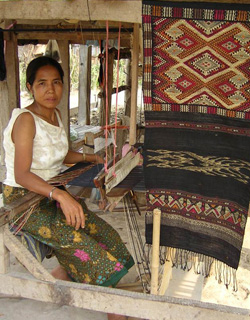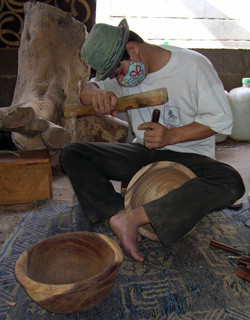Phontong Handicrafts


The Phontong Handicraft Cooperative (PHC) is a network of traditional Lao artisans which spans 35 villages and connects over 450 people. Their base is Vientiane, Lao PDR and their connections extend throughout Central and Northern Laos.
The cooperative is committed to increasing and stabilising the livelihood of Lao villagers through the renewal and support of traditional Lao handicrafts. It provides training and seeks market outlets. Their vision is to create sustainable livelihood and to promote environmentally and culturally appropriate practices in the communities where they work.
Phontong Handicraft Cooperative History
PHC was established in 1976, when a small group of 10 women who lived in Phontong Village, Vientiane, organised themselves to sell handicrafts that they produced.
At this time, Phontong Village was a haphazard settlement for the internally displaced people of Northern Laos. Tremors from the Cold War – in the form of civil strife and cluster bombs – had forced many from their homes and communities. A new communist government was in power and employment was hard to find in this time of transition.
Kommaly Chanthavong was one of the many internally displaced people living in Phontong. At the age of 11 she had left her home village near the northern town of Xam Neua and walked over 250 km through mountainous terrain in order to reach her family in Vientiane.
Video produced by Fair Trade Connection.
In 1976, two options existed for those looking for employment – find work with the Government or work within a co-op. Kommaly decided not to work for the Government, as she was hoping to help those in her community. She had noticed that many women in her village had no employment and little source of income besides the small wages men received for manual labour. She knew that many of the women from Northern Laos had learnt traditional weaving skills from their mothers and grandmothers. Equipped with this knowledge and a lot of determination, Kommaly asked 10 women to meet together in her house and start the ‘Phontong Weavers’.
In 1985, the group applied to the Government to become a recognised cooperative. Kommaly was elected as the director of the co-op, and the group legally became the ‘Phontong Handicraft Cooperative’ (PHC). PHC has become the only surviving, self-sustaining Handicraft Cooperative in Laos today.
One of the reasons why the PHC is economically sustainable can be attributed to its business structure. The Laos socialist government forbids the setting up of local NGOs, thus in 1990 PHC and CAMA Services (Compassion and Mercy Associate’s Services) set up a company called Phontong-CAMA Handicraft Cooperative with the aim to run the company as a non-profit handicraft project and as a relatively economically independent organisation. The company expanded its work to include Hmong communities (the main hill minority group in Laos).
Kommaly’s vision is to expand the benefits of the PHC to poorer areas of Laos (Kommaly herself came from the poorest region in the North). She wants to see the rural farmers engaged in the whole cycle of production from silk thread to finished handicraft products.
In 1993, Kommaly helped start Mulberries in order to work with more farmers in silk production in Hua Phan and Xieng Khouang in Northern Laos.



